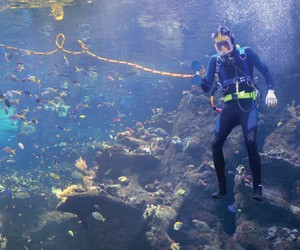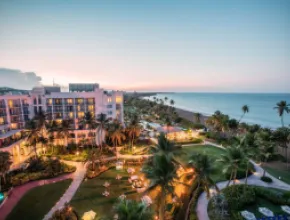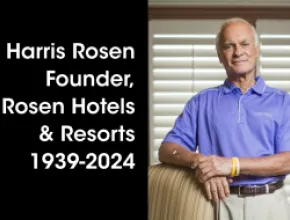Born in Port Arthur, Texas, Robert Rauschenberg (1925-2008) remains one of the art world’s most influential and productive pioneers. His 1998 retrospective in Houston was so voluminous that it took three of the city’s major museums—The Menil Collection, Contemporary Arts Museum and the Museum of Fine Arts, all part of Houston’s group-ready, 18-member Museum District—to display it all.
Best known for his multimedia “Combines” of the early 1950s, Rauschenberg’s striking collages are an apt expression of the multifaceted Texas cultural landscape, while his philosophy of “doing exactly the reverse” of what he was taught speaks to the independence of the Texas spirit. In the Lone Star State, artists, like its people, prefer to chart their own way. Cowboys, football and oil may be familiar cultural signposts, but for groups, the state’s artistic and cultural finds are as vast and diverse as Texas itself.
Great Shapes
In the “Golden Triangle” of Southeast Texas, Beaumont bills itself as the “Museum Capital of Texas” for a diverse collection including the Texas Energy Museum, Art Museum of Southeast Texas and Fire Museum of Texas, featuring the world’s largest fire hydrant.
The West Texas Triangle, meanwhile, comprises five museums in five cities forming a geographic triangle: The Grace Museum in Abilene (three institutions in one); the Old Jail Art Center in Albany (a historical and cultural tourism hotbed); the multivenue Museum of the Southwest in Midland; the oasis-like Ellen Noel Art Museum in Odessa; and The San Angelo Museum of Fine Arts, housed in an internationally acclaimed building along the banks of the Concho River in San Angelo.
San Antonio’s festive cultural milieu offers groups a number of outstanding interactions for tours and events, with several museums set within historic properties. The Southwest School of Art, on the banks of the San Antonio River, was originally a French convent from 1848. Housed in the former castle-like Lone Star Brewery, the San Antonio Museum of Art features preeminent collections of Latin American and Asian art. The newly expanded McNay Art Museum, set in a Mediterranean-style mansion, features wide-ranging collections, including theater-centered works.
The Witte Museum is San Antonio’s leading museum of South Texas history, culture and natural science; The Institute of Texan Cultures, located in HemisFair Park, chronicles more than 25 ethnic groups that made the Lone Star State what it is today; and event-favorite the Blue Star Contemporary Art Center is a hotbed of contemporary art in trendy Southtown. San Antonio is also renowned for its festivals, including the spellbinding Luminaria in March, the triumphant Fiesta San Antonio! in April and the unforgettable Dia de los Muertos (Day of the Dead) in November.
Fast becoming crown jewels of the American artistic and cultural scene, Metroplex anchors Dallas and Fort Worth boast an enviable collection of world-class group attractions.
On a national scale, the multivenue AT&T Performing Arts Center is hailed as the most significant new performing arts complex to be built since New York City’s Lincoln Center, enhancing the allure of other Dallas Arts District mainstays such as the Nasher Sculpture Center, Dallas Museum of Art, Morton H. Meyerson Symphony Center and Trammell Crow Center and Crow Collection of Asian Art. Another distinctive Dallas option is the Meadows Museum, featuring the most comprehensive collection of Spanish art outside of Spain.
Fort Worth’s treasure trove includes the 2,056-seat multipurpose Bass Performance Hall, one of Travel & Leisure’s top 10 opera houses in the world; the Amon Carter Museum of American Art, celebrating its 50th anniversary in 2011; the striking Modern Art Museum of Fort Worth, appearing to float in water; and the Kimbell Art Museum, known as “America’s best small museum.” Among the most-visited venues in the Sundance Square entertainment district, the Sid Richardson Museum features one of the finest collections of Western art in America.
The 109-acre Fort Worth Botanic Garden is the oldest in Texas, while the new facility at the group-accessible Botanical Research Institute of Texas will feature a “living” roof and is seeking LEED Platinum certification.
Another garden paradise is Galveston Island’s 428-room Moody Gardens Hotel, Spa and Convention Center. With over 100,000 square feet of meeting and convention space, Moody Gardens sits on 242 botanical acres accented by three pyramids containing a living rainforest, Texas-sized aquarium and giant-screen 3-D theater. Set on 30 acres facing the Gulf of Mexico, San Luis Resort, Spa & Conference Center boasts 700 rooms, nine restaurants and 200,000 square feet of total meeting facilities resort-wide, including the 140,000-square-foot Galveston Island Convention Center.
The El Paso Museum of Art’s permanent collection of more than 6,000 works of art includes American art from the 19th to the 21st century, Mexican colonial art and the work of late El Paso artist Tom Lea, celebrated for his extraordinary range of talents. From world-class events at the Laredo Entertainment Center to mariachi music at Plaza San Agustin, friendly Laredo mixes Spanish colonial influence and Mexican spice in celebrations including the popular International Sister Cities Festival, which marks its 10th anniversary next year.
Team Buildings
“Simply Mav-elous” gushed the Dallas Morning News when the Dallas Mavericks won their first-ever NBA title this year. As Mavericks owner Mark Cuban reportedly celebrated with a $90,000 bottle of champagne, it was also a victory for sports-mad Texas, where groups can get their game on at an array of sporting venues.
Home to the Dallas Cowboys and the Texas Rangers, Arlington also draws bowling fans to the 18,000-square-foot International Bowling Museum & Hall of Fame, flexibly accommodating up to 400 for events.
Another championship destination in the Metroplex is nearby Frisco, where the Frisco Conference Center, attached to the Embassy Suites Dallas/Frisco Hotel, Convention Center & Spa, houses the state’s second-largest ballroom. Four teams call Frisco home, including FC Dallas of Major League Soccer and Rangers’ farm club the Frisco RoughRiders, who play at Dr Pepper Ballpark. Frisco also boasts more than 200 pieces of indoor and outdoor public art.
Billed as “The Sports Capital of Texas,” Round Rock, just north of Austin, is home to a diverse mix of sports and meeting facilities, including the United Heritage Center at the Dell Diamond, a multipurpose facility that can accommodate up to 500 people for events.
In Waco, the Texas Sports Hall of Fame is available for rental, hosting up to 450 people.
It’s “Cowabunga, Podnuh!” at the Texas Surf Museum in Corpus Christi, while groups can take sand-sculpting lessons year-round on South Padre Island.
Nestled along the shores of 22,000-acre Lake Conroe, La Torretta Lake Resort & Spa’s business-recreation mix goes from the 73,000-square-foot IACC-certified conference and banquet center to diversions including golf, a multipool waterpark and numerous lake-based activities.
American rodeo began in 1883 on the ranches around Pecos, an hour west of Odessa and home to the Texas Rodeo Hall of Fame. Other rodeo shrines include Houston, where the annual Livestock Show and Rodeo is the world’s largest such event; Fort Worth, setting the stage for the annual Southwestern Exposition and Livestock Show & Rodeo (the country’s oldest) and home to cultural venues such as the National Cowgirl Museum and Hall of Fame; and Mesquite, where Resistol Arena is home to the long-running Mesquite ProRodeo, and the Mesquite Art Center is home to the city’s arts and cultural scene.
Wild mustangs once brought Spanish explorers into the future Texas. Today, the Mustangs of Las Colinas, nine bronze mustangs galloping across a stream in the heart of Irving’s Las Colinas Urban Center, is a leading visitor draw in North Texas.







